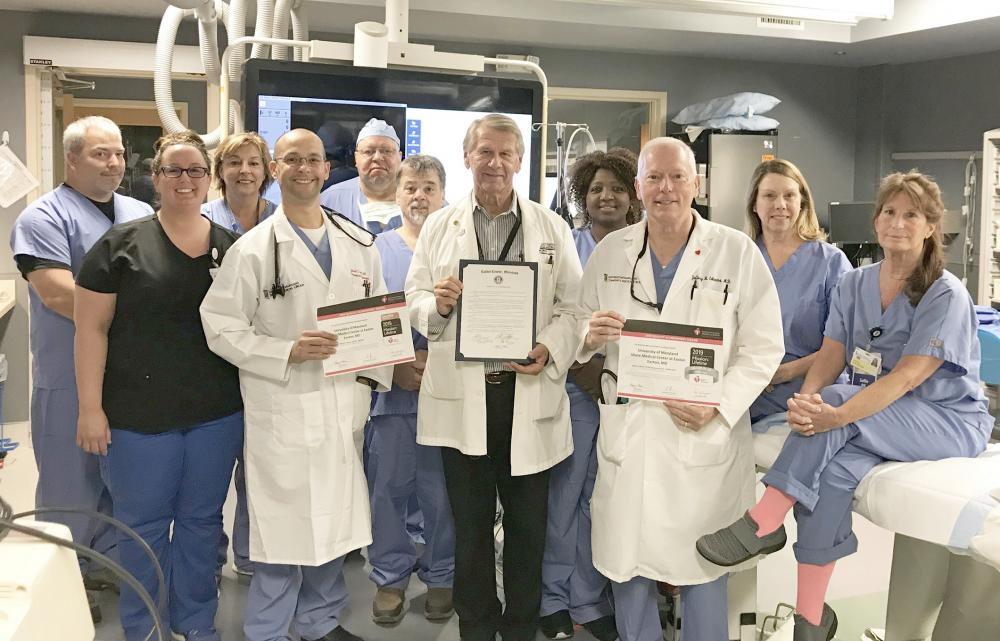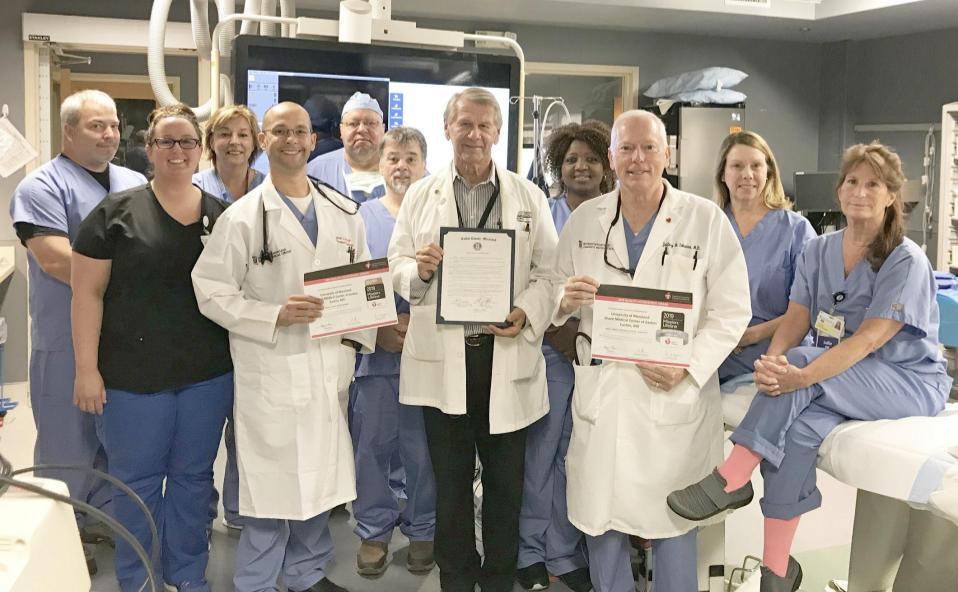University of Maryland Shore Regional Health’s Cardiac Intervention Center (CIC) has received the Mission: Lifeline® Silver Plus STEMI Receiving Center Quality Achievement Award and the Mission: Lifeline® NSTEMI Bronze Quality Achievement Award for implementing specific quality improvement measures outlined by the American Heart Association for the treatment of patients who suffer severe heart attacks. The Cardiac Intervention Center, located in UM Shore Medical Center at Easton, has been in operation since February 2018.
Additionally, following a Maryland Institute for Emergency Medical Services Systems (MIEMSS) follow-up survey this past spring, UM Shore Regional Health was issued four-year accreditation as a Cardiac Intervention Center.
Every year, more than 250,000 people experience an ST elevation myocardial infarction (STEMI), the deadliest type of heart attack, caused by a blockage of blood flow to the heart that requires timely treatment.
The American Heart Association’s Mission: Lifeline program’s goal is to reduce system barriers to prompt treatment for heart attacks. The initiative provides tools, training and other resources to support heart attack care.
“The collaboration with our emergency medical services teams throughout our five-county region is vital to patient survival,” said Gary Jones, UM Shore Regional Health’s regional director of Cardiovascular Services. “To have patients brought to us in a timely manner is critically important and EMS does a phenomenal job of evaluating patients during transport to initiate treatment and to activate the Cath Lab Call Team process.”
At UM Shore Medical Center in Easton, cardiac interventionists work with a team of nurses and technologists quickly to perform emergent percutaneous coronary intervention (PCI, formerly referred to as angioplasty with stent). PCI is a minimally invasive procedure using a catheter to place a stent that opens up blood vessels in the heart that have been narrowed by plaque buildup.

Photo: UM Shore Regional Health’s Cardiac Cath Lab Call Team is pictured celebrating a proclamation for their work presented by the Talbot County Council, held by Gary Jones, regional director of Cardiovascular Services, and two awards from the American Heart Association, held by Dr. Gabriel Sardi, left, and Dr. Jeffrey Etherton, right.
“We are proud to have met these guidelines outlined by Mission: Lifeline®. The national target for these patients entering a facility and having blood flow restored, or ‘Door to Balloon’ time, is 90 minutes. Shore Regional Health’s cardiologists and Cardiac Intervention Team are meeting that target time and then some. We are achieving ‘Door to Balloon’ times of under 60 minutes more than 98 percent of the time,” said Jones.
Jones said the life-saving PCI procedure wasn’t available in the Mid Shore region until February 2018, when the hospital was initially designated a CIC by MIEMSS.
Before the CIC designation, patients in the region experiencing STEMI heart attacks (ST-segment elevation myocardial infarction) were transferred to the closest CIC that offered treatments for this type of heart attack, which occurs in about 15 to 20 percent of all heart attack patients. Many STEMI heart attack patients were transported by ambulance or helicopter to hospitals in Annapolis, Salisbury, Seaford, Delaware or University of Maryland Medical Center in Baltimore. These transfer decisions were based on proximity to a CIC level of care but also took into account traffic and other factors that could affect the survival of a patient. Travel times alone pushed the boundaries of the desired target time of under 90 minutes, and optimally within 60 minutes.
“Having the Cardiovascular Intervention Center— and particularly providing primary PCI treatments — is a rare gift to a rural area,” said interventional cardiologist Dr. Jeffrey Etherton said. “In the past, many patients would have to travel an hour or more to other hospitals for the procedure, and when every minute counts for survival, that’s not a good option. Our Cardiac Intervention Center is a life-saving medical resource for Mid-Shore communities.”
UM SRH received these awards by participating in the American Heart Association’s Coronary Artery Disease (CAD) Get with the Guidelines® Registry, which it joined just a year ago.
“This is the first year that we have been eligible to receive AHA awards and we have received two of them — an excellent testament to our commitment to our communities and to the skill of our team,” Jones said.
Jones said Shore Regional Health is dedicated to providing optimal care for heart attack patients.
“What’s unique about our program, as recognized by the MIEMSS surveyors, is that we’re providing services to three acute care hospitals and four emergency departments. Our ability to provide this high- level of care to our community is completely dependent on ensuring that these services are available 24/7, 365 by our dedicated staff, who are always on call, to respond within 30 minutes of a STEMI emergency,” Jones said. “This requires tremendous dedication and sacrifice.”
About UM Shore Regional Health: As part of the University of Maryland Medical System (UMMS), University of Maryland Shore Regional Health is the principal provider of comprehensive health care services for more than 170,000 residents of Caroline, Dorchester, Kent, Queen Anne’s and Talbot counties on Maryland’s Eastern Shore. UM Shore Regional Health’s team of more than 2,600 employees, medical staff, board members and volunteers work with various community partners to fulfill the organization’s mission of Creating Healthier Communities Together.



Write a Letter to the Editor on this Article
We encourage readers to offer their point of view on this article by submitting the following form. Editing is sometimes necessary and is done at the discretion of the editorial staff.